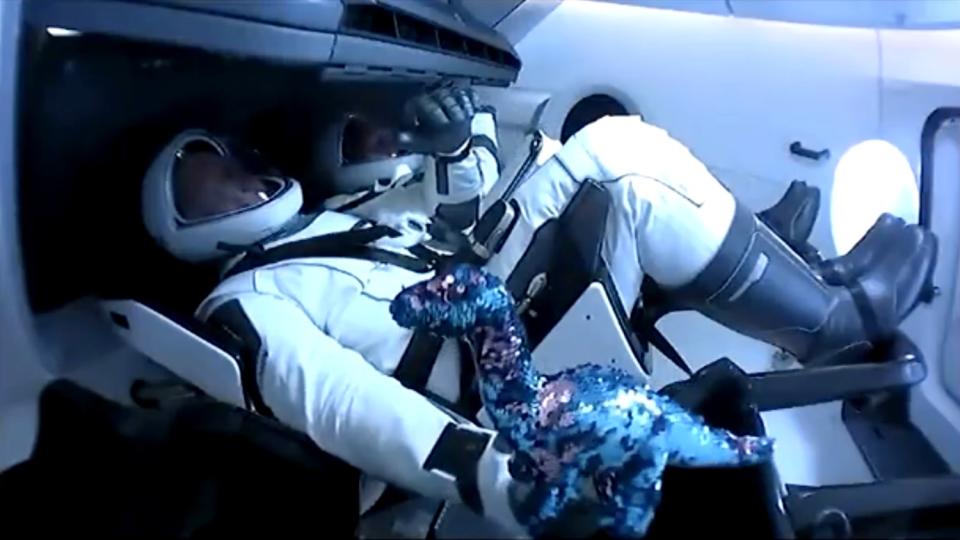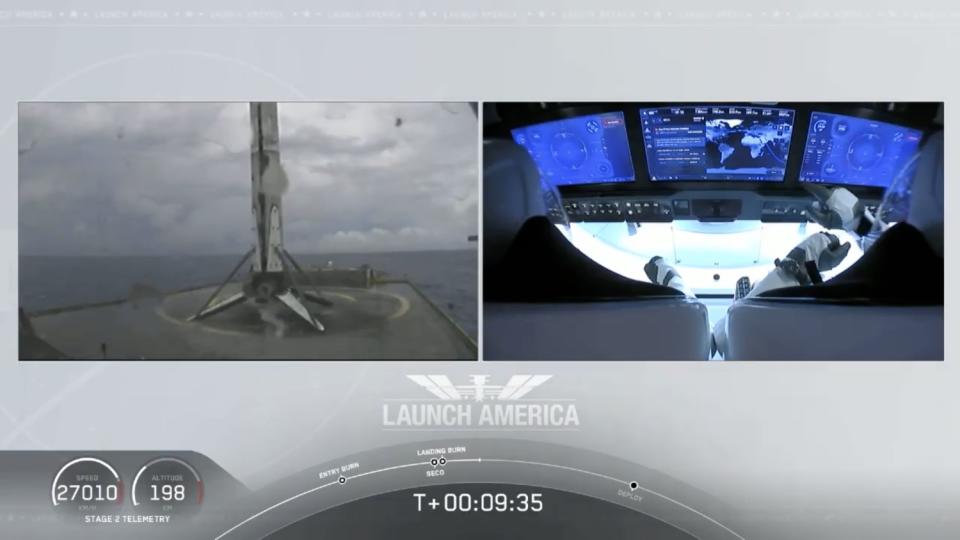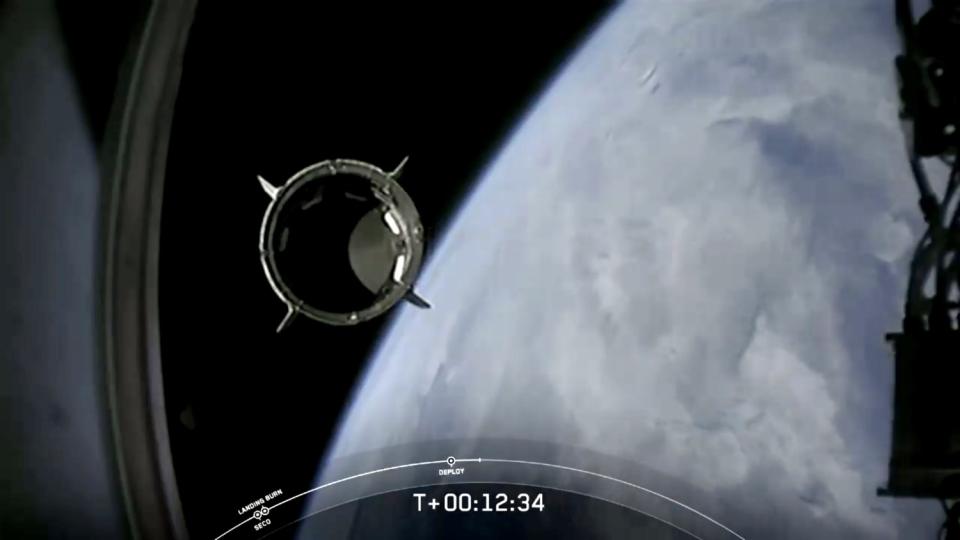New era of spaceflight dawns as SpaceX sends NASA astronauts into orbit
Riding a crackling flame out of Earth's atmosphere, two NASA astronauts on Saturday became the first to reach orbit in a craft designed and owned by a private company — marking a new era in spaceflight.
Astronauts Bob Behnken and Doug Hurley rocketed to space Saturday afternoon inside a SpaceX Crew Dragon capsule, en route to the International Space Station, where they're set to dock Sunday at 10:29 a.m. EDT.
Saturday's launch from Kennedy Space Center in Florida was the first time NASA astronauts have launched to orbit from U.S. soil in nine years.
“This has been a long time coming," NASA Administrator Jim Bridenstine said after the launch during the webcast. "I’m breathing a sigh of relief. I’ve heard that rumble before, but it’s a whole different feeling when you’ve got your team on that rocket.”
Working with a private company made it a different process, too.
The astronauts left the familiar crew quarters at Kennedy Space Center in Florida to head to the launch pad about 2½ hours before the scheduled 3:22 p.m. EDT liftoff. They air-hugged and blew kisses to their families before climbing into a white SUV adorned with NASA logos and made by Tesla — a company owned by SpaceX Chief Executive Elon Musk.
Behnken and Hurley wore sleek spacesuits designed by SpaceX and boarded a capsule with touch-screen flight control systems, a look more akin to an Apple Store than the 2,000 switches and circuit breakers needed to fly the space shuttle.
About 10 minutes before liftoff, after Behnken and Hurley were strapped into the capsule, the SpaceX team had a message for them.
"Bob, Doug, on behalf of the entire SpaceX team, it's been a huge honor to get you ready for this flight," a SpaceX employee said over their communications system. "Enjoy those views of our beautiful planet.”
Saturday's launch was the start of a test flight evaluating Crew Dragon's systems and capabilities. As the first crew ever to ride in the capsule, Behnken and Hurley will ensure everything works as expected before NASA certifies the spacecraft to regularly transport its astronauts to the space station.
"We are at the beginning," Bridenstine said during a post-launch news conference. "But so far, everything has performed very, very well.”
The launch, and years of work leading up to this point, marked a shift in how NASA does business.
For decades, NASA owned and operated the craft that ferried its astronauts to space. Contractors built the spacecraft, but they did so with heavy input from NASA.

After the space shuttle was retired in 2011, the U.S. relied solely on Russia to transport its astronauts to the space station. Those rides aren't cheap — a seat on the Russian Soyuz spacecraft costs about $70 million to $80 million.
In 2014, NASA awarded multibillion-dollar contracts to SpaceX and Boeing Co. to develop craft to transport U.S. astronauts to the space station.
Under those contracts, SpaceX and Boeing design and own the craft and NASA is simply a customer. NASA says the arrangement lets the agency focus its attention on more ambitious missions to the moon or Mars, while commercial companies take over more routine spaceflight operations in low-Earth orbit, such as carrying cargo or crew members to the space station.
"Today’s launch makes clear that the commercial space industry is the future,” President Trump said in a speech after the launch.
The shift is also a means of cost-saving at a time when NASA's budget is no longer close to the height it reached in the 1960s during the Apollo program.
Then, the Cold War smoldered between the U.S. and the Soviet Union. The two countries were in the midst of a space race to put the first man on the moon, and NASA's budget reflected that. In 1966, the space agency had an inflation-adjusted budget of about $47 billion; in 2020, NASA's budget was $22.6 billion.
"You’re not going to have that Cold War incentive every time,” said Lori Garver, NASA's deputy administrator from 2009 to 2013. "Without a Cold War, we need to reduce the costs to be able to make these advancements, and we’re doing that now.”

SpaceX made history in 2012 when its unmanned Dragon cargo capsule became the first commercial spacecraft to dock with the space station. The Hawthorne company now regularly transports cargo for NASA to the space station, as does Northrop Grumman Corp.
On Saturday, SpaceX achieved another milestone as its Crew Dragon capsule became the first private spacecraft to carry astronauts to orbit.
SpaceX has long aspired to launch humans to space. The company plans to eventually use its Crew Dragon capsule to carry tourists on trips to the space station and even higher up in space.
"We were founded in 2002 to fly people to low-Earth orbit, the moon and Mars," SpaceX President Gwynne Shotwell told reporters this month. "NASA has certainly made that possible.”

In 18 years, SpaceX has transformed from scrappy upstart to aerospace titan. The company whose first three rocket launches ended in failure has now made landing first-stage boosters back on Earth seem routine and amassed a diverse group of customers including commercial satellite operators, the U.S. military and NASA.
SpaceX's ultimate goal, however, is to colonize Mars. The company is working on a prototype of its Mars spaceship called Starship, though early versions have failed in tests.
Under the Trump administration, ambitious space plans aren't just the talk of private companies. Along with establishing a new branch of the U.S. military called the Space Force, the administration has also called for a crewed moon mission — including the first woman — by 2024.
Saturday's Crew Dragon launch was originally set for Wednesday, but inclement weather — specifically, too much electricity in the atmosphere — forced a scrub 15 minutes before liftoff.
Earlier Saturday, there was about a 50% chance the launch would take off, Bridenstine said on the launch webcast in the morning. About two hours before liftoff, a camera showing the SpaceX Falcon 9 rocket and Crew Dragon capsule on the launchpad had raindrops on its lens.
In the end, the weather cooperated.
"I’m really quite overcome with emotion," Musk said during a post-launch news conference.
The company worked nearly two decades to accomplish its goal of launching humans, he said. "It’s hard to believe it’s happened.”

 Yahoo Finance
Yahoo Finance 